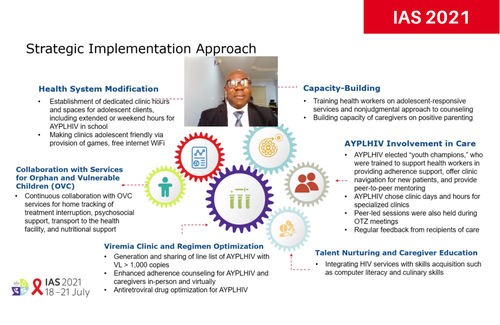
A recent study identifies the factors which contribute to the effective delivery of youth-friendly services, so as to achieve better outcomes for adolescents.
Globally, around five million adolescents (aged 15-24) are living with HIV. There is consensus that youth-friendly approaches to delivering care do support better health outcomes. However, there are gaps in knowledge about how they work in practice. This analysis explored whether specific mechanisms could influence outcomes.
HIV prevalence in Nigeria is at its lowest since 1999, at 1.4%. However, only 31% of young people aged 15-24 are aware of their status; the average in the general population is 47%. Around 90% of young people who are living with HIV are accessing treatment, but only 31% of young people aged 20-24 are virally suppressed. The average amongst those aged 15-64 is 43%. In this context, youth-friendly services are being scaled up to improve such outcomes.
Methods
The team led by Dr Okikiolu Badejo of APIN Public Health Institute in Nigeria analysed a network of PEPFAR-funded healthcare facilities which have adopted youth friendly models to deliver services. Five were in urban settings and five in rural settings.
The models included things such as multi-month dispensing and out-of-facility care. Additionally, there was a peer-support model which linked facilities to community-support networks made up of peers, community-based organisations, civil society groups, economic support and legal resources.
Interviews were conducted with two young people and one healthcare provider in each facility, to understand their perspectives and experiences in relation to various aspects of care. A total of 50 young people, aged 15-24, were recruited through their care providers or at peer support meetings. There was a roughly even split between females and males, and between people above or below 20 years of age. The majority of those aged 15-19 acquired HIV perinatally (56%), whilst 43% of those 20-24 had acquired HIV through heterosexual transmission.
The team also looked at facility-level data on retention in care and viral load suppression.
Flexible and differentiated service delivery
Differentiated service delivery is a person-centred approach that “simplifies and adapts HIV services across the cascade to reflect the preferences, expectations and needs of people living with and affected by HIV, while reducing unnecessary burdens on the health system”.
Participants reported high levels of stigma in their communities, as well as breaches of privacy and confidentiality in healthcare. Young people described how flexible and differentiated services meant that they had alternative ways to access care, which improved their engagement in care.
One healthcare worker described differentiated service delivery:
“Now waiting time has been seriously reduced by the fact that you do not have to queue to see the doctors… Adolescents only come pick drugs twice a year because we have case managers or community groups who can deliver their drugs at home.”
However, analysis showed that this had no correlation to retention rates, except in settings where there were low levels of privacy and confidentiality.
Extrinsic motivation
The theory behind this is that for young people who are socioeconomically disadvantaged, access to financial and material support linked to attending care is important to overcoming wider structural barriers.
Results showed an improvement in adherence where consistent external motivation was available, such as links to vocational work. All facilities in the study provided incentives like this, but experiences varied due to inconsistencies and differences between facilities in the availability of these resources.
One young person described:
“This support group that they are doing for us is helping us, especially we girls… that we will not go to boys to beg money or go around following boys.”
The team measured the impact of the incentives by tracking improvement in viral suppression for young people who had no education. In clinics where there were fewer young people without education, there was a significant increase in viral suppression. The opposite was observed in settings where there were more young people without education, where there was probably worse coverage of resources. Researchers assumed that where there are more young people who have remained in education, there are likely to be more resources to deliver incentives. However, this assumption is a limitation of the study.
Agency and self-efficacy
The thinking behind this is that where health workers support young people living with HIV to provide treatment support to their peers, this can enhances self-efficacy and positive adherence behaviours, which will lead to viral suppression. Peer-support groups focus on self-management of care, which allows people to define individual treatment goals, and the skills to achieve them, as well as accountability amongst peers to meet their goals.
Participants described specific instances where peers in these groups had supported them to adopt positive adherence behaviours:
“I do see all those things posted […] sometimes they advise little adolescents on how to take their medication, concerning sex education, or maybe HIV information, so like that I got educated. And now I know how I can manage myself, to deal with stigma and HIV disclosure.”
However, analysis showed weak associations between participating in peer-support networks and viral suppression.
Empowerment
This was observed as an important point because participants highlighted how personalised strategies, tailored to their specific barriers, enabled them to be proactive in improving their adherence. One healthcare worker described:
“I told him to get a diary and ‘tick everything as you take your drugs and send the diary to me on the phone’ […] after a while, he was able to monitor himself without even my supervision.”
However, the researchers didn’t have any quantitative data to explore this issue.
Conclusion
Through this analysis, the team understood that young people living with HIV are more likely to adhere to treatment and achieve viral suppression if they can be motivated by intrinsic factors (being motivated by a personal desire) or extrinsic factors (being motivated by an external reward). These should reinforce positive behaviours and will build self-control, trust, and agency.
They found seven key conditions that enable young people to achieve viral suppression.
- Privacy and confidentially
- Differentiated service delivery
- Material support
- Peer network support
- Respectful care
- Agency (in other words, having decision-making capacity and self-efficacy in relation to HIV treatment)
- Extrinsic motivation
The authors summarised their understanding as: “Health services/facilities that provide respectful care are more likely to improve viral suppression in young people living with HIV; because when they feel respected, they may be (more) motivated intrinsically (through agency-enhancing interventions) or extrinsically (through material incentives) to address and overcome adherence barriers to achieve viral suppression. Health facilities that provide agency-enhancing interventions can intrinsically motivate young people living with HIV in high-stigma and disrespectful care settings to address adherence barriers and achieve viral load suppression.”
Being able to increase viral load suppression amongst young people living with HIV depends on the capacity in health services to effectively deliver youth-friendly services . Although what is necessary may differ across services, the team believe that the conditions they have set out can support policymakers and service providers to develop their services. To improve effectiveness of youth-friendly services, health services must consider the context in which they deliver interventions, how the interventions motivate young people and how interventions are used in their context.
Badejo O et al. Understanding why and how youth-friendly health services improve viral load suppression among adolescents and young people living with HIV in Nigeria: realist evaluation with qualitative comparative analysis. BMJ Global Health 8: e012600, 2023 (open access).

